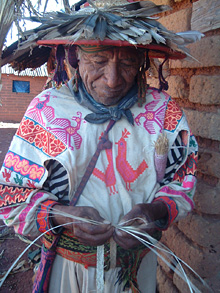
|
 |
 |
 News from Around Banderas Bay | March 2008 News from Around Banderas Bay | March 2008  
An Insight to the Indigenous Peoples of Mexico
 Rebecca Morgan - PVNN Rebecca Morgan - PVNN


| | Before coming to Mexico, I had no idea that there was such a huge number of people still living "in the past" all over the country and the whole notion really fascinates me. | | |
From the 1st to the 15th of March, Plaza Caracol, here in Puerto Vallarta, hosted the "Festival Indigena" where the indigenous people "Wixaritari of Tatei Kie" came down from the mountains where they have been living for generations to share their culture with the people of Puerto Vallarta.

This was the third year of the festival and just like previous years a large section of the shopping mall was filled with the brightly coloured hand made art work, music, photography, ritual dancing and many other events and spectacles, all of which took place in the fifteen days.

What struck me was the bravery of the "Wixaritari" people, to come into the modern world, which is no doubt extremely intimidating for them. The group of about 30 included all ages, from babies, to the elderly. They all remained calm but reserved while members of the public looked around their stalls and admired their dancing and music.

Although some members of the "Wixaritari" seemed to shy away from the glares of the few cameras which were present, many seemed intrigued by the general concept of the camera, which were obviously complete foreign objects to them.

A busy shopping mall seemed like a strange choice of location for this particular festival to me, as I can only guess that the "Wixaritari" people felt uncomfortable in this, what would be "vulgar" to them, setting.

Before coming to Mexico, I had no idea that there was such a huge number of people still living "in the past" all over the country and the whole notion really fascinates me.

The indigenous people of Mexico have always contributed a huge amount to the culture and still remain to, as while we continue to change our world and our ways of living, the indigenous peoples carry on living the way they did thousands of years ago.

According to the "National Commission for the Development of the Indigenous Peoples" there are 12 million indigenous peoples in Mexico, of many different ethnic groups which make up about 11% - 12% of the population in the country. The CDI recognizes 62 indigenous groups, each with their own language.

The indigenous peoples have a number of rights under the second article of the constitution. According to this article, their rights include:

• the right to decide the internal forms of social, economic, political and cultural organization;

• the right to apply their own normative systems of regulation as long as human rights and gender equality are respected;

• the right to preserve and enrich their languages and cultures;

• the right to elect representatives before the municipal council in which their territories are located.

I believe that the indigenous people have a very positive influence on Mexico, as they create diversity and manage to maintain a huge part of the culture, while so much else about the country is constantly changing and evolving. | 
 | |
 |



